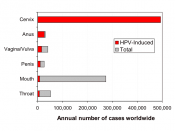Over the past few decades BC has been incredibly effective in its efforts to reduce cancer of the uterine cervix. However the decline of cervical cancer has reached a plateau; the rapid decline of the incidence and mortality rate of cervical cancer has come to a standstill. Public health efforts remain ineffective in several areas. Minority populations and people of lower socioeconomic status continue to be unreached by screening programs. Current screening techniques often fail to detect all types of cervical cancer effectively. In addition, current screening techniques also fail to detect the precursor to most cancer cases: the HPV virus. New strategies to combat cervical cancer need to be implemented in order for the numbers to continue to drop.
Cancer of the uterine cervix is the ninth most common cancer in BC with an incidence rate of 9.8 per 100,000. In BC cervical cancer rates have dropped by 70 percent since 1949 when cervical screening programs were implemented.
Incidence rates decreased steadily in the 1970's and early 80's, but this decline has slowed since about 1985( see figure: 1).Rates of mortality due to cervical cancer also decreased, from a rate of 11 per 100,00 in 1951 to 2.1 per 100,000 in 2001(see figure:2). The mortality rate of cervical cancer has declined by almost fifty percent and survival rate is seventy four percent over five years.
Cervical cancer is almost completely preventable yet in continues to be a cause of morbidity and mortality in Canada. The risk of cervical cancer is two to ten times greater in women who have not been screened. Risk increases with time between pap screenings. 1500 new cases were diagnosed in year 2000 and an estimated 430 women died from the disease the same year. In 1997 there were 1,300 new cases and 390...


